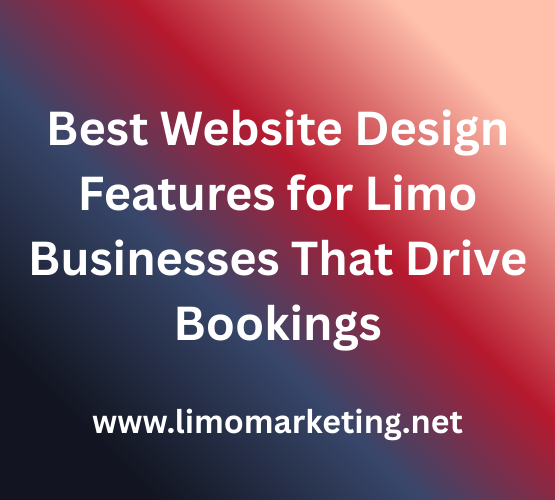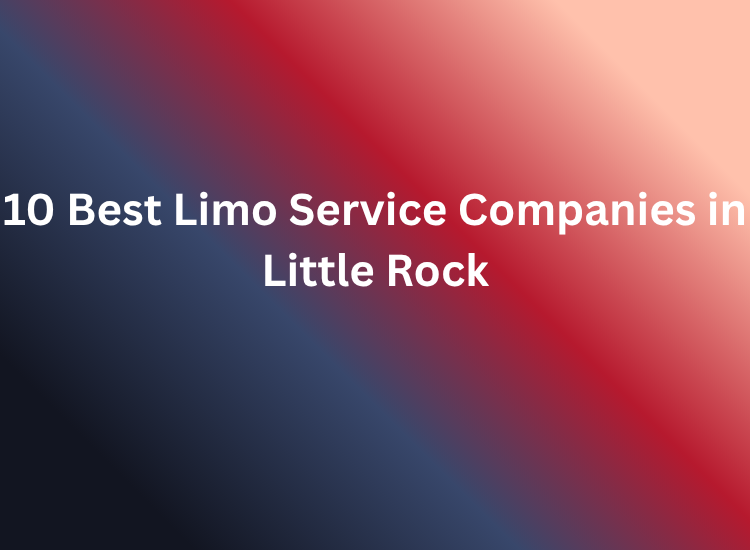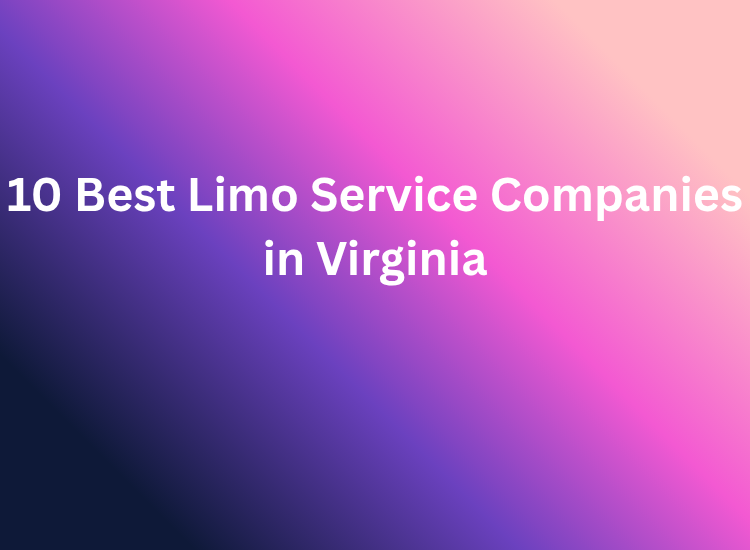Best Website Design Features for Limo Businesses That Drive Bookings
Create an Experience That Converts Visitors into Passengers
Introduction
A well-designed website is more than a digital storefront for a limousine business—it’s a strategic tool that can attract bookings, establish trust, and present your fleet in a polished and professional way. Customers searching for luxury transportation expect a site that reflects style, ease, and reliability. If your limo website lacks key features, you could lose valuable leads to more prepared competitors.
In this comprehensive guide, we’ll walk through the best website design features every limo business should consider to engage clients and generate bookings.
1. Mobile-Responsive Design
Your customers are mobile, and your website should be too. A mobile-responsive design ensures your content, images, and forms adjust smoothly across all devices—smartphones, tablets, and desktops. Since many limo bookings happen on-the-go (often during last-minute travel or events), a mobile-friendly site is essential for capturing that business.
Key elements:
- Tap-friendly buttons
- Quick loading on mobile data
- Smooth scrolling and layout adaptation
- Font readability on small screens
2. Online Booking System
An online booking form simplifies the process of reserving a vehicle. It builds convenience for your visitors and helps you collect detailed client information upfront. The booking form should be visually appealing, intuitive, and fast-loading—ideally integrated with your internal scheduling system or CRM.
Suggested fields:
- Pickup and drop-off location
- Date and time
- Vehicle preference
- Passenger count
- Contact information
3. Live Chat or Chatbot Integration
Potential customers often have quick questions they need answered before booking. Adding a live chat option or AI chatbot can dramatically reduce bounce rates and improve customer engagement. You can use chat to guide users through vehicle options, pricing, or special packages.
Benefits:
- Boosts customer confidence
- Saves time for both staff and users
- Operates 24/7 for instant communication
4. Fleet Showcase With High-Quality Images
Your fleet is your product. Make it stand out with a dedicated fleet page showcasing each vehicle using professional, high-resolution images. Include angles of both interiors and exteriors. Add brief yet descriptive details like seating capacity, luggage space, amenities, and suitable occasions (weddings, corporate, airport, etc.).
Pro tips:
- Use sliders or grid layouts
- Include filters (e.g., Sedan, SUV, Stretch Limo)
- Add client testimonial quotes below vehicle photos
5. Fast Website Speed and Performance
Website speed affects everything from user experience to search rankings. Limo clients are often making quick decisions, so if your site takes more than 2–3 seconds to load, you’re likely losing them.
Speed-boosting features:
- Compressed images
- CDN integration
- Lazy loading for media
- Clean, lightweight code structure
6. Prominent Call-to-Action (CTA) Buttons
Strategically placed CTA buttons like “Book Now,” “Get a Quote,” or “Call Us” should guide the user experience. These buttons must stand out with contrasting colors and appear on key pages—home, fleet, about, and contact.
Where to place CTAs:
- Header bar (persistent)
- Hero section
- Bottom of each page
- Floating button on mobile
7. Social Proof and Testimonials
Trust is essential when booking high-end transportation. Showcase client testimonials directly on your homepage or a dedicated “Reviews” page. Video reviews and Google Business reviews widget integrations add more credibility.
Tips:
- Add customer names (with permission)
- Include company names for corporate clients
- Use 5-star visuals or embedded Google/Facebook reviews
8. Location-Based Service Pages
Limo businesses often operate across multiple cities or regions. Create dedicated location pages to target each service area. Not only does this improve your site structure, but it also boosts local SEO and helps customers find relevant info for their city.
Include on each page:
- Local contact number
- Area-specific fleet options
- Testimonials from customers in that region
9. SEO-Optimized Page Structure
Great design goes hand-in-hand with SEO. Your limo website should be structured with optimized headings (H1, H2, H3), keyword-rich meta descriptions, and proper URL formats. Also, create internal links between related service pages to improve crawlability and session time.
Checklist:
- Use keywords like “Airport Limo Service in [City]”
- Add schema markup for local businesses
- Optimize image alt texts with fleet keywords
10. Pricing Estimator or Instant Quote Tool
Customers love transparency. Instead of asking them to call for every pricing detail, give them an instant quote tool or calculator. This feature builds trust and makes your site more interactive.
Fields to include:
- Pickup/drop-off zip code
- Service type (hourly, one-way, round trip)
- Vehicle type
- Number of hours
11. Interactive Map and Service Coverage Visuals
Add an interactive Google Map to your contact or service area page. Let users explore where you operate and get driving directions directly from their location. Use coverage radius visuals to show delivery areas.
Benefits:
- Enhances user experience
- Reinforces location-based trust
- Helps with SEO targeting for specific zones
12. Contact Page With Multiple Access Points
Your contact page should be more than a form. Include your phone number (click-to-call on mobile), email, physical office address (if applicable), and a map. Make sure the form is short and loads quickly.
Bonus features:
- Embedded calendar booking link
- WhatsApp integration
- Office hours with time zone noted
13. Blog or Resource Section
A blog builds authority and drives SEO traffic. Write articles targeting queries like “Top Wedding Limo Tips,” “How to Book Airport Transfers in [City],” or “Benefits of Corporate Limousine Services.” Use your blog to showcase your industry expertise.
Blog ideas:
- Event-based content (proms, weddings, corporate travel)
- Safety tips
- Pricing guides
- Vehicle comparison posts
14. Trust Badges and Industry Certifications
Display any associations or certifications you have—like NLA (National Limousine Association), BBB Accreditation, or insurance certifications. These badges increase trust and professionalism.
Good spots to add them:
- Website footer
- About us page
- Booking page sidebar
15. ADA-Compliant and Accessible Features
A limo website should be inclusive for all visitors. Following WCAG accessibility guidelines not only improves usability but also avoids legal risks.
Accessibility features to consider:
- Alt text on images
- High-contrast design options
- Keyboard navigation
- ARIA labels for screen readers
16. Hero Section with Clear Value Proposition
The hero section is what visitors see first. Use this space to present a strong value statement with an eye-catching image or video. Add a headline like “Luxury Limousine Services for Every Occasion in [City]” with a visible CTA button below.
Best practices:
- Add real fleet background video
- Keep text short and action-oriented
- Ensure it loads quickly
17. Security Features (SSL, Captcha, Spam Blockers)
Trust and safety matter, especially when users are submitting contact details or making online payments. Always install SSL (https://), use captcha on forms, and ensure email spam protection measures are in place.
Security additions:
- Daily backups
- HTTPS certificate
- Secure payment integrations (Stripe, PayPal)
18. Visual Storytelling with Video Tours
Nothing sells luxury like a cinematic walkthrough of your vehicles. Use short videos to show the interior of stretch limos, black SUVs, or party buses. Include narration or soft music and feature a call-to-action at the end of the clip.
Where to display videos:
- Homepage
- Fleet detail pages
- About Us
19. Event-Based Service Pages
Different events call for different messaging. Create separate pages for key events you serve—weddings, airport transfers, proms, birthdays, bachelor/bachelorette parties, and corporate services. Each page should have unique images, copy, and testimonials to fit that audience.
Benefits:
- Stronger targeting
- Better user experience
- Improved conversion for intent-based traffic
20. Simple Navigation and Mega Menus
A cluttered menu can confuse users. Use clean menus with dropdowns or mega menus to organize your services, fleet, about, and blog. Highlight the most searched-for pages right in the top menu.
Menu structure tips:
- Keep primary navigation under 6 items
- Use dropdowns for service subcategories
- Add a “Book Now” button on the top right
21. Language Translation Options (If Applicable)
If your limo business operates in a multilingual area (e.g., Miami, Los Angeles, Toronto), add a language switcher to cater to your diverse audience. Translate key pages professionally—especially booking forms and contact pages.
Commonly added languages:
- Spanish
- French
- Arabic
- Chinese
22. Customer Account Login (For Repeat Users)
Give your frequent customers the option to register an account. Business travelers and VIP clients appreciate an easy login system where they can view past trips, upcoming bookings, and preferred vehicles.
Key features:
- Booking history
- Stored addresses
- Payment methods
- Corporate discounts
23. Easy-to-Find FAQ Section
Add an FAQ page that addresses common questions about pricing, cancellation, vehicle rules, and service areas. This can reduce phone inquiries and reassure new clients.
Sample FAQs:
- Can I book a limo for multiple stops?
- How far in advance should I book?
- Are gratuities included in the quote?
24. CRM and Calendar Integration
Seamless backend operations improve customer service. Integrate your limo website with your CRM and calendar software to streamline follow-ups, reminders, and staff coordination.
Popular tools:
- Zoho CRM
- HubSpot
- Google Calendar Sync
- Calendly
25. Strong About Us Page
People connect with people. Use the About Us page to tell your story—when you started, your commitment to service, and your passion for luxury transport. Add staff photos and any awards or client logos.
Elements to include:
- Mission statement
- Company timeline
- Awards or press mentions
Conclusion: A Website That Drives Bookings
Your limo website isn’t just a digital brochure—it’s a conversion engine. With smart design features, fast load times, easy navigation, strong visuals, and helpful content, you can drive more bookings and elevate the customer experience.
As competition grows in luxury transport, a professional, functional, and strategic site design becomes a non-negotiable asset.
Want a High-Converting Limo Website?
At Limo Marketing, we specialize in building websites specifically for limo businesses. From online booking systems to SEO-focused layouts, we help you turn traffic into paying clients. Book a consultation and let’s build a digital experience worthy of your fleet.






